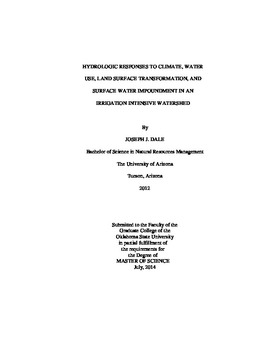| dc.contributor.advisor | Zou, Chris B. | |
| dc.contributor.author | Dale, Joseph J. | |
| dc.date.accessioned | 2015-06-17T20:05:26Z | |
| dc.date.available | 2015-06-17T20:05:26Z | |
| dc.date.issued | 2014-07-01 | |
| dc.identifier.uri | https://hdl.handle.net/11244/14788 | |
| dc.description.abstract | Climatic variability and land surface change have a wide range of often difficult to parse out effects on streamflow. We analyzed long-term records of climate, land use and land cover, and re-constructed the water budget based on precipitation, groundwater levels and water use for the time period from 1950 through 2010 for an irrigation intensive agricultural watershed in the Southern Great Plains, USA. Increase of surface impounding structures is a unique feature in land surface transformation for the Southern Great Plains. In the United States the highest density of farm ponds is in the Southern Great Plains and specifically in the state of Oklahoma. These represent a significant form of anthropogenic alteration to the landscape. Despite the vast proliferation of these small reservoirs in the state, very few studies have evaluated the ecosystem services and the effects of these water bodies on the hydrologic cycle. We quantified surface water storage in Oklahoma using remote sensing techniques. We qualitatively assess the potential effects of small reservoirs such as farm ponds, stock ponds, animal and industrial waste lagoons, and small flood control reservoirs on streamflow.For the study period, we found a general trend of increases in grass and woody cover, rapid increase in urban area and surface impoundment. The atmosphere demand (ET0) has trended downward due largely to increase in relative humidity and no trend in temperature change. We found that streamflow was most sensitive to changes in precipitation when annual water consumption for irrigation was high between 1965 and 1984 and was less responsive to precipitation variability since 1985. The changes in the total area of agricultural land and the encroachment of woody species into grassland have been negatively correlated with streamflow over the past 30 years when groundwater pumping has been relatively constant. We found a strong linear correlation between the logs of reservoir capacity and water surface area at multiple spatial scales - state, watershed and county, suggesting a potential in rapid assessment of surface water storage in impounding structures using remote sensing data for this region.For a watershed with heavy anthropogenic alteration, there is a need to consider drivers aside from the traditional climatic ones and thus, water use, land use and land cover change can all be included in a holistic adaptation and mitigation strategy. | |
| dc.format | application/pdf | |
| dc.language | en_US | |
| dc.publisher | Oklahoma State University | |
| dc.rights | Copyright is held by the author who has granted the Oklahoma State University Library the non-exclusive right to share this material in its institutional repository. Contact Digital Library Services at lib-dls@okstate.edu or 405-744-9161 for the permission policy on the use, reproduction or distribution of this material. | |
| dc.title | Hydrologic Responses to Climate, Water Use, Land Surface Transformation, and Surface Water Impoundment in an Irrigation Intensive Watershed | |
| dc.type | text | |
| dc.contributor.committeeMember | Long, James | |
| dc.contributor.committeeMember | Liang, Ye | |
| osu.filename | Dale_okstate_0664M_13615.pdf | |
| osu.accesstype | Open Access | |
| dc.description.department | Natural Resources and Ecology Management | |
| dc.type.genre | Thesis | |
